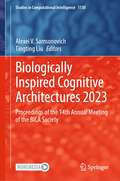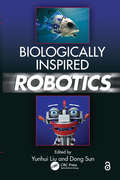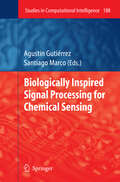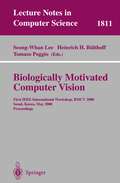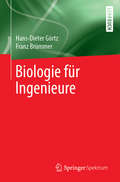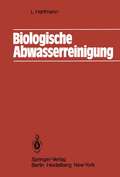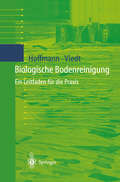- Table View
- List View
Biologically Inspired Cognitive Architectures 2023: Proceedings of the 14th Annual Meeting of the BICA Society (Studies in Computational Intelligence #1130)
by Alexei V. Samsonovich Tingting LiuThe book focuses on original approaches intended to support the development of biologically inspired cognitive architectures. It bridges together different disciplines, including artificial intelligence, linguistics, neuro- and social sciences, psychology and philosophy of mind, among others. The chapters are based on contributions presented at the 2023 Annual International Conference on Brain-Inspired Cognitive Architectures for Artificial Intelligence (the 14th Annual Meeting of the BICA Society, BICA*AI 2023), organized in collaboration with the University of Ningbo and held on October 13-15, 2023, in Ningbo, China. The book discusses emerging methods, theories and ideas towards the realization of general-purpose humanlike artificial intelligence or fostering a better understanding of the ways the human mind works. It provides engineers, mathematicians, psychologists, computer scientists and other experts with a timely snapshot of recent research and a source of inspiration for future developments in the broadly intended areas of artificial intelligence and biological inspiration.
Biologically Inspired Computer Vision: Fundamentals and Applications
by Gabriel Cristobal Matthias Keil Laurent PerrinetAs the state-of-the-art imaging technologies became more and more advanced, yielding scientific data at unprecedented detail and volume, the need to process and interpret all the data has made image processing and computer vision increasingly important. Sources of data that have to be routinely dealt with today's applications include video transmission, wireless communication, automatic fingerprint processing, massive databanks, non-weary and accurate automatic airport screening, robust night vision, just to name a few. Multidisciplinary inputs from other disciplines such as physics, computational neuroscience, cognitive science, mathematics, and biology will have a fundamental impact in the progress of imaging and vision sciences. One of the advantages of the study of biological organisms is to devise very different type of computational paradigms by implementing a neural network with a high degree of local connectivity. This is a comprehensive and rigorous reference in the area of biologically motivated vision sensors. The study of biologically visual systems can be considered as a two way avenue. On the one hand, biological organisms can provide a source of inspiration for new computational efficient and robust vision models and on the other hand machine vision approaches can provide new insights for understanding biological visual systems. Along the different chapters, this book covers a wide range of topics from fundamental to more specialized topics, including visual analysis based on a computational level, hardware implementation, and the design of new more advanced vision sensors. The last two sections of the book provide an overview of a few representative applications and current state of the art of the research in this area. This makes it a valuable book for graduate, Master, PhD students and also researchers in the field.
Biologically Inspired Computer Vision: Fundamentals and Applications
by Gabriel Cristobal Laurent Perrinet Matthias S. Keil Jeanny HeraultAs the state-of-the-art imaging technologies became more and more advanced, yielding scientific data at unprecedented detail and volume, the need to process and interpret all the data has made image processing and computer vision increasingly important. Sources of data that have to be routinely dealt with today's applications include video transmission, wireless communication, automatic fingerprint processing, massive databanks, non-weary and accurate automatic airport screening, robust night vision, just to name a few. Multidisciplinary inputs from other disciplines such as physics, computational neuroscience, cognitive science, mathematics, and biology will have a fundamental impact in the progress of imaging and vision sciences. One of the advantages of the study of biological organisms is to devise very different type of computational paradigms by implementing a neural network with a high degree of local connectivity. This is a comprehensive and rigorous reference in the area of biologically motivated vision sensors. The study of biologically visual systems can be considered as a two way avenue. On the one hand, biological organisms can provide a source of inspiration for new computational efficient and robust vision models and on the other hand machine vision approaches can provide new insights for understanding biological visual systems. Along the different chapters, this book covers a wide range of topics from fundamental to more specialized topics, including visual analysis based on a computational level, hardware implementation, and the design of new more advanced vision sensors. The last two sections of the book provide an overview of a few representative applications and current state of the art of the research in this area. This makes it a valuable book for graduate, Master, PhD students and also researchers in the field.
Biologically Inspired Control of Humanoid Robot Arms: Robust and Adaptive Approaches
by Adam Spiers Said Ghani Khan Guido HerrmannThis book investigates a biologically inspired method of robot arm control, developed with the objective of synthesising human-like motion dynamically, using nonlinear, robust and adaptive control techniques in practical robot systems. The control method caters to a rising interest in humanoid robots and the need for appropriate control schemes to match these systems. Unlike the classic kinematic schemes used in industrial manipulators, the dynamic approaches proposed here promote human-like motion with better exploitation of the robot’s physical structure. This also benefits human-robot interaction.The control schemes proposed in this book are inspired by a wealth of human-motion literature that indicates the drivers of motion to be dynamic, model-based and optimal. Such considerations lend themselves nicely to achievement via nonlinear control techniques without the necessity for extensive and complex biological models.The operational-space method of robot control forms the basis of many of the techniques investigated in this book. The method includes attractive features such as the decoupling of motion into task and posture components. Various developments are made in each of these elements. Simple cost functions inspired by biomechanical “effort” and “discomfort” generate realistic posture motion. Sliding-mode techniques overcome robustness shortcomings for practical implementation. Arm compliance is achieved via a method of model-free adaptive control that also deals with actuator saturation via anti-windup compensation. A neural-network-centered learning-by-observation scheme generates new task motions, based on motion-capture data recorded from human volunteers. In other parts of the book, motion capture is used to test theories of human movement. All developed controllers are applied to the reaching motion of a humanoid robot arm and are demonstrated to be practically realisable.This book is designed to be of interest to those wishing to achieve dynamics-based human-like robot-arm motion in academic research, advanced study or certain industrial environments. The book provides motivations, extensive reviews, research results and detailed explanations. It is not only suited to practising control engineers, but also applicable for general roboticists who wish to develop control systems expertise in this area.
Biologically Inspired Design: Computational Methods and Tools
by Ashok K. Goel Daniel A. McAdams Robert B. StoneFrom simple cases such as hook and latch attachments found in Velcro to articulated-wing flying vehicles, biology often has been used to inspire many creative design ideas. The scientific challenge now is to transform the paradigm into a repeatable and scalable methodology. Biologically Inspired Design explores computational techniques and tools that can help integrate the method into design practice. With an inspiring foreword from Janine Benyus, Biologically Inspired Design contains a dozen chapters written by some of the leading scholars in the transdisciplinary field of bioinspired design, such as Frank Fish, Julian Vincent and Jeannette Yen from biology, and Amaresk Chakrabarti, Satyandra Gupta and Li Shu from engineering. Based in part on discussions at two workshops sponsored by the United States National Science Foundation, this volume introduces and develops several methods and tools for bioinspired design including: Information-processing theories, Natural language techniques,Knowledge-based tools, andFunctional approaches and Pedagogical techniques.By exploring these fundamental theories, techniques and tools for supporting biologically inspired design, this volume provides a comprehensive resource for design practitioners wishing to explore the paradigm, an invaluable guide to design educators interested in teaching the method, and a preliminary reading for design researchers wanting to investigate bioinspired design.
Biologically Inspired Design: A Primer (Synthesis Lectures on Engineering, Science, and Technology)
by Torben A. Lenau Akhlesh LakhtakiaAs the existence of all life forms on our planet is currently in grave danger from the climate emergency caused by Homo sapiens, the words "sustainability" and "eco-responsibility" have entered the daily-use vocabularies of scientists, engineers, economists, business managers, industrialists, capitalists, and policy makers. Normal activities undertaken for the design of products and systems in industrialisms must be revamped. As the bioworld is a great resource for eco-responsible design activities, an overview of biologically inspired design is presented in this book in simple terms for anyone with even high-school education. Beginning with an introduction to the process of design in industry, the book presents the bioworld as a design resource along with the rationale for biologically inspired design. Problem-driven and solution-driven approaches for biologically inspired design are described next. The last chapter is focused on biologically inspired design for environment.
Biologically-Inspired Optimisation Methods: Parallel Algorithms, Systems and Applications (Studies in Computational Intelligence #210)
by Andrew Lewis Sanaz Mostaghim Marcus RandallBiologically Inspired Robot Behavior Engineering (Studies in Fuzziness and Soft Computing #109)
by Richard J. Duro Jose Santos Manuel GranaThe book presents an overview of current research on biologically inspired autonomous robotics from the perspective of some of the most relevant researchers in this area. The book crosses several boundaries in the field of robotics and the closely related field of artificial life. The key aim throughout the book is to obtain autonomy at different levels. From the basic motor behavior in some exotic robot architectures right through to the planning of complex behaviors or the evolution of robot control structures, the book explores different degrees and definitions of autonomous behavior. These behaviors are supported by a wide variety of modeling techniques: structural grammars, neural networks, and fuzzy logic and evolution underlies many of the development processes. Thus this text can be used by scientists and students interested in these areas and provides a general view of the field for a more general audience.
Biologically Inspired Robotics
by Yunhui Liu Dong SunRobotic engineering inspired by biology—biomimetics—has many potential applications: robot snakes can be used for rescue operations in disasters, snake-like endoscopes can be used in medical diagnosis, and artificial muscles can replace damaged muscles to recover the motor functions of human limbs. Conversely, the application of robotics technology to our understanding of biological systems and behaviors—biorobotic modeling and analysis—provides unique research opportunities: robotic manipulation technology with optical tweezers can be used to study the cell mechanics of human red blood cells, a surface electromyography sensing system can help us identify the relation between muscle forces and hand movements, and mathematical models of brain circuitry may help us understand how the cerebellum achieves movement control. Biologically Inspired Robotics contains cutting-edge material—considerably expanded and with additional analysis—from the 2009 IEEE International Conference on Robotics and Biomimetics (ROBIO). These 16 chapters cover both biomimetics and biorobotic modeling/analysis, taking readers through an exploration of biologically inspired robot design and control, micro/nano bio-robotic systems, biological measurement and actuation, and applications of robotics technology to biological problems. Contributors examine a wide range of topics, including:A method for controlling the motion of a robotic snakeThe design of a bionic fitness cycle inspired by the jaguarThe use of autonomous robotic fish to detect pollutionA noninvasive brain-activity scanning method using a hybrid sensorA rehabilitation system for recovering motor function in human hands after injuryHuman-like robotic eye and head movements in human–machine interactions A state-of-the-art resource for graduate students and researchers in th
Biologically Inspired Robotics
by Yunhui Liu Dong SunRobotic engineering inspired by biology—biomimetics—has many potential applications: robot snakes can be used for rescue operations in disasters, snake-like endoscopes can be used in medical diagnosis, and artificial muscles can replace damaged muscles to recover the motor functions of human limbs. Conversely, the application of robotics technology to our understanding of biological systems and behaviors—biorobotic modeling and analysis—provides unique research opportunities: robotic manipulation technology with optical tweezers can be used to study the cell mechanics of human red blood cells, a surface electromyography sensing system can help us identify the relation between muscle forces and hand movements, and mathematical models of brain circuitry may help us understand how the cerebellum achieves movement control. Biologically Inspired Robotics contains cutting-edge material—considerably expanded and with additional analysis—from the 2009 IEEE International Conference on Robotics and Biomimetics (ROBIO). These 16 chapters cover both biomimetics and biorobotic modeling/analysis, taking readers through an exploration of biologically inspired robot design and control, micro/nano bio-robotic systems, biological measurement and actuation, and applications of robotics technology to biological problems. Contributors examine a wide range of topics, including:A method for controlling the motion of a robotic snakeThe design of a bionic fitness cycle inspired by the jaguarThe use of autonomous robotic fish to detect pollutionA noninvasive brain-activity scanning method using a hybrid sensorA rehabilitation system for recovering motor function in human hands after injuryHuman-like robotic eye and head movements in human–machine interactions A state-of-the-art resource for graduate students and researchers in th
Biologically Inspired Signal Processing for Chemical Sensing (Studies in Computational Intelligence #188)
by Agustín Gutiérrez Santiago MarcoBiologically inspired approaches for artificial sensing have been extensively applied to different sensory modalities over the last decades and chemical senses have been no exception. The olfactory system, and the gustatory system to a minor extent, has been regarded as a model for the development of new artificial chemical sensing s- tems. One of the main contributions to this field was done by Persaud and Dodd in 1982 when they proposed a system based on an array of broad-selective chemical sensors coupled with a pattern recognition engine. The array aimed at mimicking the sensing strategy followed by the olfactory system where a population of bro- selective olfactory receptor neurons encodes for chemical information as patterns of activity across the neuron population. The pattern recognition engine proposed was not based on bio-inspired but on statistical methods. This influential work gave rise to a new line of research where this paradigm has been used to build chemical sensing instruments applied to a wide range of odor detection problems. More recently, some researchers have proposed to extend the biological inspiration of this system also to the processing of the sensor array signals. This has been mo- vated in part by the increasing body of knowledge available on biological olfaction, which has become in the last decade a focus of attention of the experimental neu- science community.
Biologically Inspired Techniques in Many Criteria Decision Making: Proceedings of BITMDM 2021 (Smart Innovation, Systems and Technologies #271)
by Sung-Bae Cho Satchidananda Dehuri Bhabani Shankar Prasad Mishra Pradeep Kumar MallickThis book includes best-selected, high-quality research papers presented at Second International Conference on Biologically Inspired Techniques in Many Criteria Decision Making (BITMDM 2021) organized by Department of Information & Communication Technology, Fakir Mohan University, Balasore, Odisha, India, during December 20-21, 2021. This proceeding presents the recent advances in techniques which are biologically inspired and their usage in the field of many criteria decision making. The topics covered are biologically inspired algorithms, nature-inspired algorithms, multi-criteria optimization, multi-criteria decision making, data mining, big-data analysis, cloud computing, IOT, machine learning and soft computing, smart technologies, crypt-analysis, cognitive informatics, computational intelligence, artificial intelligence and machine learning, data management exploration and mining, computational intelligence, and signal and image processing.
Biologically Inspired Techniques in Many-Criteria Decision Making: International Conference on Biologically Inspired Techniques in Many-Criteria Decision Making (BITMDM-2019) (Learning and Analytics in Intelligent Systems #10)
by Satchidananda Dehuri Bhabani Shankar Prasad Mishra Pradeep Kumar Mallick Sung-Bae Cho Margarita N. FavorskayaThis book addresses many-criteria decision-making (MCDM), a process used to find a solution in an environment with several criteria. In many real-world problems, there are several different objectives that need to be taken into account. Solving these problems is a challenging task and requires careful consideration. In real applications, often simple and easy to understand methods are used; as a result, the solutions accepted by decision makers are not always optimal solutions. On the other hand, algorithms that would provide better outcomes are very time consuming. The greatest challenge facing researchers is how to create effective algorithms that will yield optimal solutions with low time complexity. Accordingly, many current research efforts are focused on the implementation of biologically inspired algorithms (BIAs), which are well suited to solving uni-objective problems. This book introduces readers to state-of-the-art developments in biologically inspired techniques and their applications, with a major emphasis on the MCDM process. To do so, it presents a wide range of contributions on e.g. BIAs, MCDM, nature-inspired algorithms, multi-criteria optimization, machine learning and soft computing.
Biologically Modified Polymeric Biomaterial Surfaces
by E. Piskingap always exists between the material performance generation of new molecules along with the release during in-vivo animal tests and clinical situations, of substances from a multitude of cells. The plasma because of the difference in individual reactions proteins (including coagulation and complement proteins), the blood cells deposited on the material between one animal and another and humans. Likewise, sophisticated in-vitro and in-vivo models surface or circulating in the blood stream and their are being developed to study living body responses. released substances take part in the dynamic process of fibrinolysis and thrombus formation. Progress has been achieved in culturing mammalian cells, particularly human cells, which has lead to new in-vitro models to study cell-biomaterial Tissue response interactions. These techniques are discussed in the other chapters of this volume. Materials implanted in tissues always generate a response. The major tissue response in the extra BIOLOGICAL MODIFICATION vascular system is an inflammatory process, which may be induced chemically or physically. Many Surfaces of polymeric biomaterials may be modified proteins and cells are involved in this very complex by using a variety of biological entities (e.g.
Biologically Motivated Computer Vision: First IEEE International Workshop BMCV 2000, Seoul, Korea, May 15-17, 2000 Proceedings (Lecture Notes in Computer Science #1811)
by Seong-Whang Lee Heinrich H. Bülthoff Tomaso PoggioIt is our great pleasure and honor to organize the First IEEE Computer Society International Workshop on Biologically Motivated Computer Vision (BMCV 2000). The workshop BMCV 2000 aims to facilitate debates on biologically motivated vision systems and to provide an opportunity for researchers in the area of vision to see and share the latest developments in state-of-the-art technology. The rapid progress being made in the field of computer vision has had a tremendous impact on the modeling and implementation of biologically motivated computer vision. A multitude of new advances and findings in the domain of computer vision will be presented at this workshop. By December 1999 a total of 90 full papers had been submitted from 28 countries. To ensure the high quality of workshop and proceedings, the program committee selected and accepted 56 of them after a thorough review process. Of these papers 25 will be presented in 5 oral sessions and 31 in a poster session. The papers span a variety of topics in computer vision from computational theories to their implementation. In addition to these excellent presentations, there will be eight invited lectures by distinguished scientists on “hot” topics. We must add that the program committee and the reviewers did an excellent job within a tight schedule.
Biologically Rationalized Computing Techniques For Image Processing Applications (Lecture Notes in Computational Vision and Biomechanics #25)
by Jude Hemanth Valentina Emilia BalasThis book introduces readers to innovative bio-inspired computing techniques for image processing applications. It demonstrates how a significant drawback of image processing – not providing the simultaneous benefits of high accuracy and less complexity – can be overcome, proposing bio-inspired methodologies to help do so. Besides computing techniques, the book also sheds light on the various application areas related to image processing, and weighs the pros and cons of specific methodologies. Even though several such methodologies are available, most of them do not provide the simultaneous benefits of high accuracy and less complexity, which explains their low usage in connection with practical imaging applications, such as the medical scenario. Lastly, the book illustrates the methodologies in detail, making it suitable for newcomers to the field and advanced researchers alike.
Biologically Responsive Biomaterials for Tissue Engineering (Springer Series in Biomaterials Science and Engineering #1)
by Iulian AntoniacDevelopments in the area of biomaterials, bionanotechnology, tissue engineering, and medical devices are becoming the core of health care. Almost all medical specialties involve the use of biomaterials, and research plays a key role in the development of new and improved treatment modalities. This volume focuses on several current trends in tissue engineering, remodelling and regeneration. Leading researchers describe the use of nanomaterials to create new functionalities when interfaced with biological molecules or structures. In addition to coverage of basic science and engineering aspects, a range of applications in bionanotechnology are presented, including diagnostic devices, contrast agents, analytical tools, physical therapy applications, and vehicles for targeted drug delivery. The use of polymers, alloys, and composites, or a combination of these, for biomaterials applications in orthopaedics is also explored. These contributions represent essential reading for the biomaterials and biomedical engineering communities, and can serve as instructional course lectures targeted at graduate and post-graduate students.
Biologie für Ingenieure
by Hans-Dieter Görtz Franz BrümmerIn vielen Ingenieurstudiengängen brauchen die Studierenden eine Einführung in die Biologie, wofür im Studienplan meist nur ein kleines Zeitfenster zur Verfügung steht. Dieses Buch soll das konzentrierte Nacharbeiten und eine gezielte Vorbereitung auf Prüfungen ermöglichen und Neugierde wecken.In diesem Kurzlehrbuch werden die wichtige Zusammenhänge und Funktionsprinzipien der modernen Biologie, die generelle Methodik und die wesentlichen Eigenschaften der Lebewesen und Lebensgemeinschaften vorgestellt. Wie ist der Weg vom Gen zum Organ und zum Verhalten? Weshalb ist nicht zu erwarten, dass ein Lebewesen dauerhaft perfekt ist? Ein Überblick über die Mechanismen der Evolution und die Vielfalt der Lebewesen und Lebensstrategien wird gegeben. Auf wichtige Inhalte wird in Merksätzen aufmerksam gemacht, vertiefende oder besonders aktuelle Aspekte werden in Vertiefungs-Kästen dargestellt. Es soll dabei noch keine Lehrbuch der Ingenieurbiologie sein, sondern die notwendige, kompakte Vorbereitung auch auf diese.Über viele Jahre haben die Autoren Erfahrungen in Einführungsvorlesungen in die Biologie für Ingenieure, Informatiker und Naturwissenschaften gewonnen. Den Anschluss an weiterführende Veranstaltungen (z. B. der Bioverfahrenstechnik und der Umweltgestaltung) zu finden, ist für Studierende schon wegen der unterschiedlichen Fachsprache und Denkweise von Naturwissenschaftlern und Ingenieuren eine Herausforderung. Auch dazu dienen Ausführungen über und Hinweise z.B. auf die Systembiologie, Synergetik und die rasante Methodenentwicklungen.
Biologie für Ingenieure
by Hans-Dieter Görtz Franz BrümmerIn vielen Ingenieurstudiengängen brauchen die Studierenden eine Einführung in die Biologie, wofür im Studienplan meist nur ein kleines Zeitfenster zur Verfügung steht. Dieses Buch soll das konzentrierte Nacharbeiten und eine gezielte Vorbereitung auf Prüfungen ermöglichen und Neugierde wecken.In diesem Kurzlehrbuch werden die wichtige Zusammenhänge und Funktionsprinzipien der modernen Biologie, die generelle Methodik und die wesentlichen Eigenschaften der Lebewesen und Lebensgemeinschaften vorgestellt. Wie ist der Weg vom Gen zum Organ und zum Verhalten? Weshalb ist nicht zu erwarten, dass ein Lebewesen dauerhaft perfekt ist? Ein Überblick über die Mechanismen der Evolution und die Vielfalt der Lebewesen und Lebensstrategien wird gegeben. Auf wichtige Inhalte wird in Merksätzen aufmerksam gemacht, vertiefende oder besonders aktuelle Aspekte werden in Vertiefungs-Kästen dargestellt. Es soll dabei noch keine Lehrbuch der Ingenieurbiologie sein, sondern die notwendige, kompakte Vorbereitung auch auf diese.Über viele Jahre haben die Autoren Erfahrungen in Einführungsvorlesungen in die Biologie für Ingenieure, Informatiker und Naturwissenschaften gewonnen. Den Anschluss an weiterführende Veranstaltungen (z. B. der Bioverfahrenstechnik und der Umweltgestaltung) zu finden, ist für Studierende schon wegen der unterschiedlichen Fachsprache und Denkweise von Naturwissenschaftlern und Ingenieuren eine Herausforderung. Auch dazu dienen Ausführungen über und Hinweise z.B. auf die Systembiologie, Synergetik und die rasante Methodenentwicklungen.
Biologische Abluftreinigung: Grundlagen — Planung — Betrieb (VDI-Buch)
by Günter KobeltEin übersichtlich strukturierter, umfassender Führer zu einem aktuellen Thema. Wer sich ohne viel Mühe in die theoretischen wie praktischen Grundlagen dieses Gebietes einarbeiten will, findet hier schnell Rat und Hilfe. Hinweise für Planung, Bau und Betrieb von Biofilter und Biowäscher.
Biologische Abwasserreinigung (Springer-Lehrbuch)
by Ludwig HartmannIn diesem einführenden Lehrbuch gibt der Autor einen fundierten Überblick über die Zielvorstellungen und Methoden der biologischen Abwasserbehandlung, ausgehend von den ökologischen, mikrobiologischen und technologischen Grundlagen. Er beschreibt die innere Struktur der Verfahrenstechniken und macht sie auch dem Nichtbiologen verständlich. Da gleichzeitig Anwendungsmöglichkeiten und -grenzen diskutiert werden, vermittelt das Buch nicht nur Grundlagenkenntnisse, sondern auch Ansätze zur praktischen Umsetzung.
Biologische Abwasserreinigung
by Ludwig HartmannDie Darstellung der Materie läßt erkennen, daß der Autor über langjährige Erfahrungen aus der Forschung auf diesem Gebiet verfügt. Er beschreibt die innere Struktur der Verfahrenstechniken und macht sie auch dem Nichtbiologen verständlich. Da gleichzeitig die Anwendungsmöglichkeiten und -grenzen diskutiert werden, vermittelt das Buch nicht nur Grundlagenkenntnisse; es zeigt auch Ansätze für weitere Entwicklungen auf. Die Erkenntnisse und Auffassungen des Autors werden in verständlicher, leicht faßbarer Form, insbesondere durch Ergänzung mit einer Vielzahl von Bildern und Tabellen, dargestellt und regen zu einer kritischen Bewertung an. Die Neuauflage berücksichtigt gewandelte Betrachtungsweisen und technische Fortschritte, beispielsweise: Der Rohstoffcharakter des Abwassers wird betont, Möglichkeiten des Recycling werden aufgezeigt. Die Behandlung der anaeroben Verfahren wird ihrer Bedeutung entsprechend ausgeweitet.
